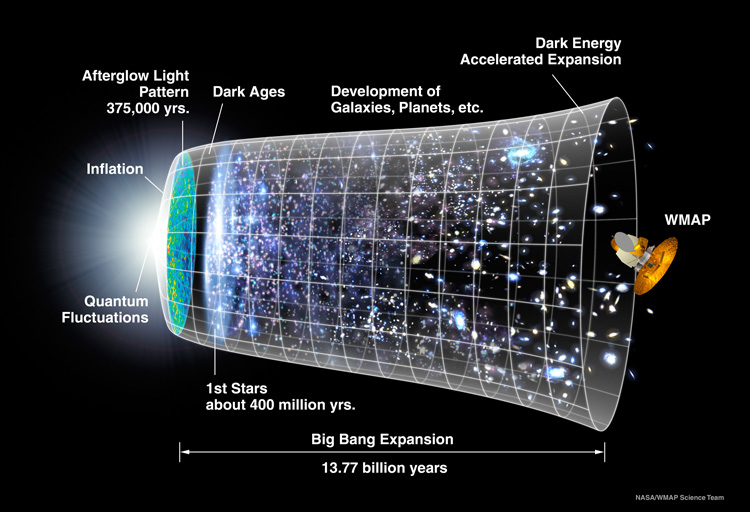WMAP Special Exhibit
How old is the universe?
You can tell how old a fallen tree was when it died by counting the rings in its trunk. No one was around when the universe was born, but there are tricks to determining how old it is too.
We get an idea about how old objects are in the universe when we see their light. The speed of light is constant, and distance is a measure of time. When we see a distant star explosion that occurs billions of light years away, we know that that star exploded billions of years ago. Likewise, seeing the light from the very first stars or seeing the afterglow of the Big Bang will tell us when these events occurred.

A representation of the evolution of the universe over 13.77 billion years. The far left depicts the earliest moment we can now probe, when a period of "inflation" produced a burst of exponential growth in the universe. For the next several billion years, the expansion of the universe gradually slowed down as the matter in the universe pulled on itself via gravity. More recently, the expansion has begun to speed up again as the repulsive effects of dark energy have come to dominate the expansion of the universe. The afterglow light seen by WMAP was emitted about 375,000 years after inflation and has traversed the universe largely unimpeded since then. The conditions of earlier times are imprinted on this light; it also forms a backlight for later developments of the universe. (Credit: NASA/WMAP Science Team)
Determining distances and thus age can be tricky business. We have one constant, the speed of light, which is about 300,000 kilometers a second. We have another ruler called redshift.
Objects moving away from us emit light that is "redshifted," meaning its wavelengths are shifted from higher energy to lower energy. A star that is really blue might look red if it is moving away from us fast enough, for the higher-energy blue wavelengths have shifted to lower-energy red wavelengths.
In the universe, everything outside of our local group of galaxies is moving away. Imagine the universe as a rising loaf of raisin bread, in which the raisins represent the galaxies. As the loaf rises, other galaxies move away from our galaxy. The more distant the galaxy, the faster it is moving away. And the faster something recedes, the greater the redshift in the light it emits.

The expansion of the universe can be thought of like raisin bread - the raisins are galaxies and as the universe expands, there is more and more space between the galaxies. Just like the bread dough rises. (Credit: NASA/Cosmic Times/Joe Petsko)
Yet the fact that distant objects have greater redshift is merely relative, though. There is no firm number or constant that allows us to say that a redshift of "x" quantity equals a distance of "y" kilometers. Scientists make educated guesses on the relationship between redshift and distant. WMAP worked to eliminate the guesswork by determining this connection.
The redshift-distance connection depends on the mass content of the universe and the cosmological constant, or dark energy. WMAP worked to determine both of these parameters. The speed of light is constant in a vacuum, but it varies as it penetrates the dust and gas of space. Knowing how much mass is out there, then, will lead to a value for the speed of light in this medium. Dark energy acts to accelerate the expansion of the universe. The greater the force of dark energy, the faster the acceleration and thus the greater the distance traveled by receding galaxies. So knowing the contribution of dark energy, termed the cosmological constant, places another limit on the redshift-distance connection.
Once we have a firm redshift ruler, we can measure the distance and age of all types of objects with greater accuracy. First on the agenda: the cosmic microwave background. This microwave light as a redshift. The redshift yields the distance. The distance (knowing the speed of light) yields the age. So we can determine the age of the universe by dating its first light, which broke free 400,000 years after that initial spark called the Big Bang.
Scientists think the universe is about 10 to 15 billions years old. Expect WMAP to determine a much more precise age.Published: July 2001
Text Reviewed: September 2018


